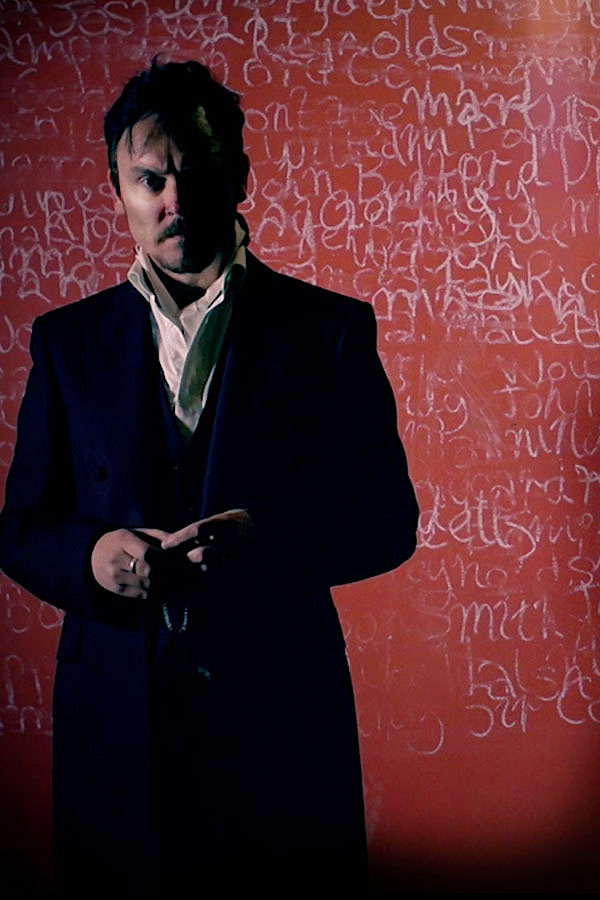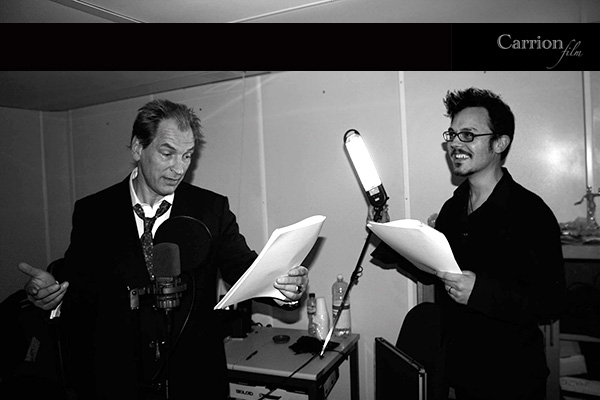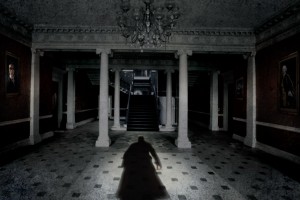In 2010, a trio of English filmmaker Ashley Thorpe’s short animated movies so captivated audiences at the fifth annual Buried Alive Festival, that they created the Visionary Award just for him. Ashley alas can’t make it back across the pond for the 12th annual Buried Alive (Nov. 15-19 at 7 Stages), but his Carrion Films‘ first feature BORLEY RECTORY is a much-anticipated festival highlight, screening Saturday Nov. 18 at 8 pm.
Ashley’s previous works formed a portmanteau of supernatural legends from Devon, where he resides with his wife Sue who played the femme fatale of “Scayrecrow,” a haunted highwayman’s revenge tale with a distinctly Hammer Films vibe. Also played at Buried Alive 5 were “The Screaming Skull” and “The Hairy Hands.” BORLEY RECTORY is an eerie documentary chronicling the historic paranormal investigations of an Essex manor nicknamed “The Most Haunted House in England.” The unique look and high quality of his earlier works allowed him to expand the production to his most ambitious yet and attracted the star power of a who’s who of British character actors including Julian Sands (GOTHAM), Reece Shearsmith (LEAGUE OF GENTLEMEN), Nicholas Vince (HELLRAISER), and Jonathan Rigby (ROUND THE HORNE…REVISITED). In the past few years, Ashley also realized a lifelong dream to become a cover illustrator and interviewer for Fangoria, the seminal horror movie magazine for anyone who came of age from the ‘70s onward.
ATLRetro caught up with Ashley to find out more about his quest to summon the specters of BORLEY RECTORY and more macabre matters.
ATLRetro: You grew up on Hammer Horror and your shorts have a bit of a Hammer look, even with some “cameos” as I recall in “Scayrecrow.” Did Hammer movies inspire you to be a filmmaker? Which is your favorite and why?
Ashley Thorpe: I’ve always loved Hammer horror. It was the Universal classics of the ’30s and Hammer horrors that were the first horror films that I felt brave enough to watch as a kid. I thought they were glorious. I was actually inspired to become a filmmaker via animation, so weirdly it was artists like Svankmajer, the Brothers Quay and David Lynch that made me believe that this was a medium that could really express the things going on in my head. The influence came back when I was producing “Scayrecrow,” a tale of a ghostly highwayman, and started imagining what it would have been like if Hammer had produced it, full of blood and thunder!
 How did you first learn about Borley Rectory and what about it, other than the obvious “most haunted house in England,” inspired you to make a film about it?
How did you first learn about Borley Rectory and what about it, other than the obvious “most haunted house in England,” inspired you to make a film about it?
I discovered the story in the USBOURNE BOOK OF GHOSTS at the local library as a boy. I was very susceptible to frightening material when I was young—due to suffering from night terrors—but there was something especially haunting about this one story and I just kept going back to it like a tongue probing a bad tooth. I loved that moniker “The Most Haunted House in England.” This wasn’t just “a” haunting, it was “THE” haunting.
The story is replete with such delicious gothic imagery—a nun bricked up within the walls, a phantom carriage driven by a headless coachman, cold spots and spectral messages scrawled upon the walls. Wonderful material. It also represented the beginning of that blend of scientific method meets the supernatural which, of course, was such a huge influence upon things like Shirley Jackson‘s THE HAUNTING OF HILL HOUSE and Richard Matheson‘s HELL HOUSE. At the time it was quite groundbreaking. Now, of course, it all seems so archetypal. Its fascination also lies with the people. All the major players in that case were curious characters. They’re all quite mercurial and mysterious so at the end of the case you’re left with more questions than answers. In fact, the ghosts are far easier to pin down than those investigating them!
Is it correct that BORLEY RECTORY started out as a short but expanded into a full feature? Can you talk about why you decided to take that bigger plunge with this particular project and how the finished film differs from your original concept?
Incredibly the thing developed organically. It wasn’t initially a conscious decision until quite late into the project. As each cast member came on board—from Reece onwards—I amended the script to give more interesting scenes, better dialogue, all without even considering how this would affect the running time! They were so good I wanted to give them more material. Seems obvious now, but at the time I was so buried in the practicalities of animating, trying to earn a living, looking after my then baby daughter, the day-to-day things, that it wasn’t really until I cut together the first seance scene last year that I realized that there was no way that this would be a 30-minute film.
Surprisingly though the finished film doesn’t really differ from the original concept at all. Another thing that I hadn’t really anticipated was how the pacing would affect the overall running time. Again it sounds ludicrous. I wanted BORLEY RECTORY to harken back to an earlier age of cinema, far from the machine gun edits and gimmicks of modern horror. I wanted long slow takes, so your eyes can explore the frame and realize that you’ve been staring at a ghost all along. One of my favorite sequences lasts for about two minutes and consists of about four edits intercutting between a little girl staring into the darkness at the end of her bed and what she sees there in the shadows.
You have some pretty prominent British character actors involved, some of whom like Julian Sands and Nicholas Vince, are familiar to US horror fans. Any stories about how they became involved and what it’s like to work with them?
I worked with Nicholas—albeit briefly—on “The Hairy Hands,” wherein he contributed the voice of one of the radio callers and we kept in touch hoping to work together again. I met Julian initially via a retrospective that I wrote for Fangoria on Ken Russell’s GOTHIC (1986). Julian found my short films online, loved them, and after watching them asked if I was working on anything currently. As it happened I had just finished the script for BORLEY RECTORY. So we recorded Julian’s narration around Christmas 2011 and then some additional passages at Trident Studios last year. Both Julian and Nicholas are wonderful, genuine, sincere people. They’ve both been so supportive and done nothing but sing the praises of the production since it started. Whenever we meet it really is like meeting old friends. My children pretty much consider Nicholas a part of the family!
And Steven Severin of Siouxsie and the Banshees was to do the soundtrack. How did you meet him and what happened with his illness?
Again Steven Severin became involved with the project due to a Fangoria interview. He was touring VAMPYR [(1932) silent film soundtrack] and performed in my home town, so I grabbed the opportunity to interview him about his work both past and present. We kept in touch and I suppose Steven must have looked into what else I did apart from the Fangoria journalism and came straight out and asked me if I was working on any animations and would I consider him scoring my next venture. I’ve always been a huge Banshees fan so I was over the moon.
As to how it was working with him, I haven’t really had much of an opportunity. The curse of Borley struck again. Steven has been in consistently poor health since recovering from a kidney transplant while we were shooting. For a while it looked as if he was going to be fine and was keen on cracking on with the scoring. Around the time that the first cut was sent over early this year Steven suffered a major pulmonary embolism and was rushed to hospital. So, after discussing it with Steven and agreeing it was definitely the best plan until he could complete or create a companion piece, the remaining scoring duties were completed by my long-term collaborator Mick Grierson who did an amazing job at scoring the film beautifully under ridiculous time constraints.
Although he is still recovering Steven has stressed that he is still planning on finishing the special music for the pledged vinyls, but until he is out of hospital I cannot unfortunately give a concrete date as to when this will be. It’s all been a bit of a car crash really, and it’s been down to Mick that the film even reached completion when it did.
Financing an independent film is always a huge challenge. You did two Indiegogo campaigns, as I recall, and had some prominent supporters like best-selling author Neil Gaiman singing your praises. Did you also have private investors? How did you do it?
Yes, the project was financed via two Indiegogo campaigns. The first one raised just shy of £7K back in 2013 which—although about £3K short of our target—allowed us to get the production underway in the summer of 2014 and shoot the majority of Reece’s sequences as his involvement had raised the profile of the project tenfold. Once I’d animated that central montage of the journalist essentially telling us the legend, we rolled out a second campaign that raised a further £13K in the end. The campaigns themselves were a huge amount of work but I was lucky on the second one to have a team behind me led by my producer’s wife Alice Bonasio. She stressed that I should concentrate on generating media to share while she and a small team “got it out there.” It was very successful.
The money raised was channeled directly into the production: hiring the studios, equipment, costumes etc. I did have a couple of private benefactors who put extra money into the production, and it was due to them that I was able to continue working on the film as although the production was financed I was made redundant [laid off] pretty much at the start of production and essentially lost my livelihood. These people kept me going at a time when it seemed as if everything—redundancy, family illnesses, burnt-out Macs—was loaded against me finishing it.
Your previous films have all had a distinctive look, i.e. animated but not necessarily what the average viewer would expect as an animated film. Can you talk a little about the effects you employed for this film to make it…dare I say…genuinely scary?!
Yes, they’re not your traditional animation. They are a collage of a number of different techniques really. The actors are all filmed against green screen and then rotoscoped whilst the backgrounds are all digitally painted and animated over. There’s a little traditional animation in there—some of the ghosts are painted—and a little 3D stuff done in After Effects, such as the aerial shots of the Rectory, but my aim was to take the footage of the actors and make them resemble the look of the “painted” backgrounds as much as possible. I also spent a great deal of time working into the footage to take the digital shine off of it using masks with various strengths of blurring to emulate a depth of field that we’d really struggle with doing live at the green screen composite level. BORLEY RECTORY has pretty much every technique I know applied in it in some way.
BORLEY RECTORY has already screened at a number of festivals and has a few awards under its belt. Where has it screened so far and have you been pleased with the audience response?
Response so far has been staggering really. It’s not an easy sell or an obvious “crowd pleaser,” it’s what I call a “Marmite film,” but it’s been snapped up by the festivals and feedback has been very positive. I think we’ve played 14 so far with more coming in weekly and all those initial festival appearances were by request rather than us having to submit via normal channels which is incredible. We premiered at GrimmFest in Manchester October 8 and then played Cinemagic in Belfast, Dead of Night Southport, Telluride Horror Show in Colorado, Celluloid Screams in Sheffield, Horror-Rama Toronto and the Folk Horror Revival in Edinburgh. Last week we won “Best Animated Feature” at Buffalo Dreams and after Buried Alive in Atlanta, we’re set to play Sydney, Australia at A Night of Horror festival. One of my favorite responses was from Lisi Russell, Ken Russell’s wife, who wrote a lovely review online. She adored it.
“Thorpe’s vision of the legend is elegant, meticulously cinematic, beautifully spooky, atmospherically enveloping. The detailed and seamlessly inter-woven animation and rotoscope by multi-talented Thorpe is hypnotic, shocking, visually stunning–each shot an artwork. This is a film for film noir lovers as well as haunted house and psycho-horror fans, conjuring up echoes of classic early British horror films like THE INNOCENTS, THE HAUNTING, PSYCHO. Asks important and unusual questions about what we need from ghosts as well as what they need from us. This film is very, very different. Ken Russell seal of approval.” – Lisi Russell
You came to Atlanta in 2010 when Buried Alive screened three of your shorts and I believe you have a certain fondness for this festival. Is it special to you that it’s screening here and what can you say to anyone on the fence about attending Buried Alive?
I had enormous fun when I came across in 2010. It was actually my first bonafide horror festival and I didn’t really know what to expect, but the team behind it were so passionate about what they were doing and really made me feel special. So many great memories. The festival itself is wonderfully eclectic as well. They program every aspect of the genre, so there really is something for everyone. The genre should be about diversity—there should be room for every style, every era—and Buried Alive reflects that beautifully. I really wish that I could have made it out there to attend in person, and with my film’s production history in mind, the fact that my film has been programmed right before a screening of ED WOOD is genius.
You also are an artist and have done a bunch of Fangoria covers, as well as writing articles for Fango. What was that like and how do you feel about the recent demise of that seminal horror movie magazine?
Well. Fangoria was a big part of my youth. I fell in love with it at high school back in the ’80s, and growing up in a small British town it was something of a revelation. Pre-Internet, these films and their production felt a million miles away, so finding Fangoria on the newsstands was incredibly exciting. At school, it felt like an outlaw magazine. So you can imagine how excited I was to be asked by [then-editor] Chris Alexander to both write and eventually produce covers for it. As a result, I got to meet wonderful people like John Hurt, Peter Sasdy, and, of course, it put me in touch with people like Julian.
How it all collapsed is really sad. You could see that there was serious trouble brewing when the payments became few and far between and contributors started bailing. I’m still owed hundreds of dollars which I’m sure I’ll never see, and judging from some of the vitriol online, my story is not an uncommon one. The publisher ran it into the ground and destroyed it. So sad.
What’s next for Carrion Films?
Apart from touring and then sourcing distribution for BORLEY. I’ll be catching up on some illustration work and looking towards the next project. We have a couple of options. A script for SPRING HEEL JACK exists in an early form which would be a Victorian melodrama. I also have HELL TOR which would be an Amicus-style portmanteau based upon Dartmoor ghost stories. Although there looks to be a chance that my next project may be adapting a popular British genre screenwriter’s novella. We’re in talks with the agent at the moment so we’ll see what happens next.
Purchase advance tickets to BORLEY RECTORY and passes to Buried Alive Film Festival here.
All photos provided by Carrion Films and used with permission.














